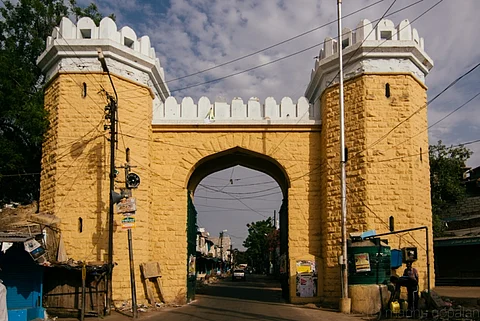

The hidden secrets of a city make it what it is, and Hyderabad has plenty. Innumerable heritage buildings dot its landscape, some of them in plain sight that people pass everyday without noticing, and some hidden away in nooks and corners. Here is a selection of a few such gems.
Darwazas into the walled city
The Qutb Shahi Sultanate that ruled the kingdom of Golconda, fell in the 17th century after Mughal emperor Aurangzeb’s forces captured the Golconda Fort. The last Sultan Tana Shah was taken away and imprisoned in the Daulatabad Fort, where he died more than a decade later. There was a period of Mughal occupation after this, during which a wall was built around the city. It was washed away by a flood, and rebuilt during the reign of the first Nizam. The wall had 13 entrances or darwazas to enter the city. Today, the wall is almost entirely gone, and so are all gates except two - the Dabirpura Darwaza in the Dabirpura neighbourhood and the Purana Pul Darwaza at one end of the old bridge over the Musi river.
Dabirpura Darwaza
Purana Pul Darwaza
An unfinished fort
The Golconda Fort is almost synonymous with Hyderabad, but one of the least known things about the city is that a few dilapidated remains of an unfinished fort still exist in a residential neighborhood near Saroornagar. Sultan Muhammad Qutb Shah, the 6th Sultan of Golconda, began to build a new fort at this site about 10km east of the city center in 1620, probably intending to make it his capital. Sadly, while the construction was going on, the Sultan died of typhoid. His son, the next Sultan Abdullah Qutb Shah, discontinued the construction because his father’s illness and death led him to believe that the site was inauspicious.
Remains of the fort that was never fully built
A mosque and a tomb in Khairatabad
Khairati Begum or Khairat-un-Nissa Begum was the daughter of Sultan Muhammad Qutb Shah, the ruler mentioned above. She had a mosque built in the Khairatabad locality (named after her) dedicated to her tutor, Akhund Mulla Abul Malik, in a typically Qutb Shahi style. Close to the mosque is an empty tomb that was built by the tutor for himself, but since he died while on a pilgrimage and not in Hyderabad, he was never buried in it.
The empty tomb in Khairatabad
Khursheed Jah Baradari
The Paigah nobility of princely Hyderabad was founded by Abul Fateh Khan Tegh Jung Bahadur, a soldier who was appointed to protect the second Nizam of Hyderabad. He was given the hereditary title Paigah, because he commanded an army, called a Paigah. Sons of the Paigah family traditionally married princesses from the Nizam’s family, so they were the most powerful nobles in Hyderabad. Nawab Khursheed Jah Paigah was the maternal grandson of the third Nizam. Khursheed Jah Baradari, his residence, is just a stone’s throw away from the more famous Chowmahalla Palace, and is one of Hyderabad’s loveliest buildings. It is a gorgeous Palladian mansion with imposing pillars and a distinctly European design, and is built as a baradari (literally means having 12 doors). Its construction was started by the Nawab’s grandfather, and completed by his father.
Khursheed Jah Baradari
Gate Portion of Dewan Devdi
Hyderabad’s highest ranking nobles other than the Paigahs, were called the Umra-e-Uzzam. Among them were the illustrious Salar Jung family, five members of which served as Prime Minister to the Nizam. Salar Jung I was a great connoisseur of art, a trait that he passed on to his grandson Salar Jung III, whose massive collection of priceless artefacts is displayed in the Salar Jung Museum. Dewan Devdi, their sprawling residence, was opposite to where the Madina Hotel stands today. It was where the Salar Jung Museum was first set up, before it was moved to its present location. The gate portion of the mansion is all that remains of it now.
Only the gate to Dewan Devdi remains now
These beautiful buildings are just the tip of the iceberg - although a lot of Hyderabad's heritage has been lost to the ravages of time and indifference, it might well take a lifetime even to explore all the treasures that remain.
All Photos: Madhumita Gopalan